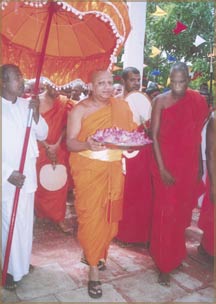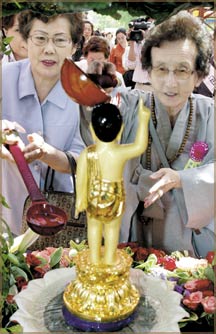|
DAILY NEWS ONLINE |
|
|
|
OTHER EDITIONS |
|
|
|
|
|
|
|
|
|
OTHER LINKS |
|
|
|
|
|
|
 |

The Buddha's birthday celebrations in Korea
|
|
|
Of all the holidays and celebrations in Korea, none are perhaps more colourful and festive than Buddha's birthday which falls on May 15th this year.
Whether you are Buddhist or not, the holiday is a wonderful opportunity to experience a bit of Korean culture for a different kind of path to enlightenment.
Ever since coming to Korea over 15 years ago, I look forward to the Buddha's birthday every year here in Seoul. It's really beautiful to see all these colorful lanterns hanging everywhere around the city, especially in some of the more traditional areas in the city like around Chogye-sa Temple or Bongeun-sa Temple near the COEX Center.
Even on some of the lesser-traveled paths around the city, you will find the neighborhoods colorfully decorated with lanterns.
Of course, if you are really into celebrating the Buddha's birthday, there's probably no better place to be than on the streets around Chogye-sa Temple in Chongno when the annual Lantern Parade is held prior to the holiday. It's really impressive to watch or be a part of this river of lanterns slowly moving through the city.
To be sure, the Buddha's birthday is one of the few holidays and festivals in Korea that foreign residents and visitors can either participate in _ from making paper lanterns at Bongeun-sa Temple or even joining in the parade through the streets of Seoul or enjoying the festivities around Chogye-sa Temple. In recent years the festival has grown considerably and it has definitely become one of the ``must see'' festivals in Korea if you are here around this time of the year.
In recent years, the celebration has taken on a more international feel in Seoul with a variety of cultural events held around the holiday including music and dance exhibitions as well as a food fair. Although Chogye-sa is currently being renovated, there is plenty of Buddhist culture to experience in the surrounding neighborhoods.
It's nice to see the international community taking part in the celebration in more ways than one.
Living in Asia for the past 16 years, I have been fascinated with Buddhism for a variety of reasons.
Even before I made the decision to live and work in Japan and then later Korea, I had already become interested in Buddhism for purely literary reasons as a graduate student immersing myself into the works of Gary Snyder and other poets who had tapped into Oriental philosophy. I was intrigued with Eastern philosophy whether it was its basic precepts or sensory underpinnings that found their way into literary works.
I wouldn't be surprised that many Western expats who end up in Asia at one time or another have also been just as intrigued and interested in Buddhism.
To be sure, when I came to Asia - first Japan and then later Korea and Thailand - I became even more interested and fully embraced Buddhism on my own path to enlightenment. While never intending to give up my Christian upbringing, I found myself growing more and more fascinated with Buddhism and its cultural heritage in Asia. Over the years I've read up as much as I could on Buddhism, participated in various ceremonies, and even tried meditating just to understand more about its significance - both in every day life as well as it's historical and cultural heritage.
Some of my fondest memories and endearing images of living and traveling around Asia are associated with Buddhism. From the tranquility of rock gardens at temples in Kyoto in autumn, the Sokkuram Buddha with its peaceful expression on its granite face in Kyongju, or saffron-robed monks slowly walking down a road in a small village in northern Thailand early in the morning, these images have formed the critical mass of my path to enlightenment.
Likewise, a visit to most any Buddhist temple is a sensory experience that is hard to forget - whether it's the mesmerizing sound of monks chanting, the sweet, earthy smell of incense burning, or the cool, dark interior of a temple on a hot, summer day.
If you've hadn't had the chance to experience Korea's Buddhist heritage yet, Buddha's birthday is a good start. No matter if you only want to paint a lantern and march in a parade, join others in the celebration, or if you seek a much deeper understanding of what Buddhism has to offer, Buddha's Birthday is one celebration in Korea you don't want to pass up.
On the other hand, it's not like you have to wait once a year for Buddha's Birthday to enjoy this part of Korean culture. Get out and explore some of the beautiful temples around the country. While most foreign visitors know about some of the more famous temples like Bulguk-sa in Kyongju, there are countless temples in other cities and provinces waiting to be explored.
While it might seem to most outsiders that most Buddhist temples look the same, each one has its own unique history, not to mention various legends and myths. Besides, what better way to experience some of the country by hiking up a mountain to explore one of these temples? Then there's always a temple stay which is one of the best ways to learn more about Buddhism and its unique place in Korean culture.
Whether you plan on participating in any of the Buddha's Birthday festivities this year, or visit any of the country's more famous temples, you are in for a real cultural treat. Who knows, you just might find yourself walking down your own path to cultural enlightenment and wanting to learn more about Korea's Buddhist heritage.
Is Kandarodei in Jaffna, former Kadurugoda Viharaya?
There is a historical place called 'Kandarodei' situated in the midst of palmyrah trees beyond Manipai about 10 Kilometres away from Jaffna. There are small dagobas numbering 61 scattered over about 1/2 acre land. Those small structures are constructed with ash-coloured stone. Some dagobas have only the foundation.
|
|
The special feature of these ancient Buddhist structures is that there are no square shape constructions (Hathares Kotuwa) above the global structures; instead there are Pesa Walalu (umbrella shape structures one above the other) next to the global structures.
This place is believed to have called Kadurugoda Vihara in the past. Dr. Paul E. Pieris first discovered these dagobas. He says the constructions are more than 2000 years old.
A Buddha statue, Bodhisaththa statue, a stone scripture and some coins believed to be in the 1st and 2nd centuries were found in this area. They are preserved at Jaffna museum.
This place of Buddhist worship has been converted to a Hindu temple at present. No attention is being paid to the dagobas.
There is a small Buddha's shrine-room constructed recently by the military personnel not far for the ancient Buddhist structures.
The military also provides security to this place.
It is believed that the relics of 60 Arhants are deposited in the small dagobas. There is a record that a special dagoba with the Buddha's relics was in this premises.
According to a legend about 2000 years before there lived 60 Arhants in Jaffna peninsula preaching Dhamma and practising meditation. Owing to a famine in the area all the 60 Arhants passed-away.
Their bodies had been cremated and the ashes deposited in the small dagobas constructed later by a noble person lived in the area, but no name or any other information has been found in records. The Department of Archaeology should take steps to protect this site of historical value and proper research should be conducted to establish a real history behind Kandarodei / Kadurugoda temple.
These facts were provided by Udula Sriyani Jayaweera, a journalist from Matale who toured in Jaffna recently.
From Anguttara Nikaya : Bhojana Sutta - a meal
In giving a meal, the donor gives five things to the recipient. Which five? He/she gives life, beauty, happiness, strength and quick-wittedness.
Having given life, he/she has a share in long life, either human or divine. Having given beauty he/she has a share in beauty, either human or divine. Having given happiness, he/she has a share in happiness, either human or divine. Having given strength, he/she has a share in strength either human or divine. Having given quick wittedness, he/she has share in quick-wittedness either human or divine. In giving a meal, the donor gives these five things to the recipient.
The prudent person gives life, strength, beauty, quick wittedness - the wise person, a giver of happiness attains happiness himself.
Having given life, strength, beauty, happiness and quick wittedness he has long life and status whenever he arises.
 |
Ven. Pallegama Sirinivasa Thera, the Chief Incumbent of Anuradhapura Atamasthana who returned to Anuradhapura after receiving a very rare honour from Thailand is being led in procession to worship Sri Maha Bodhi. Earlier, he was accorded a warm reception by many well-wishers including the Governor, Dr. Jagath Balasooriya, Chief Minister, Berty Premalal Dissanayaka and Indigenous Medicine Minister Tissa Karalliyadda. - (Picture by Senapura D. Nissanka, Anuradhapura East group correspondent) |
|
|
 |
 |
 |
 |


